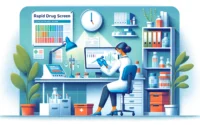What is a Drug Screen? Exploring Drug Screening and Testing Methods
Last Updated on July 4, 2023 by Lily
Drug screening plays a vital role in various industries, including healthcare, sports, law enforcement, and workplaces, to ensure safety, compliance, and fairness. This article aims to provide a comprehensive understanding of drug screening, its purpose, methods, and the difference between drug screening and drug testing.
What is a Drug Screening?
Drug screening refers to the process of testing individuals for the presence of drugs or their metabolites in their system. It is used to determine if someone has recently used drugs or is currently under the influence of substances that may impair their ability to perform tasks safely and effectively. Drug screening is commonly conducted in various settings, including workplaces, healthcare facilities, sports organizations, and law enforcement agencies.
The purpose of drug screening is to promote safety, compliance, and fairness. It helps organizations maintain a drug-free environment, protect individuals from potential harm, and ensure that rules and regulations are followed. Drug screening methods may involve the analysis of urine, blood, saliva, or hair samples, depending on the specific requirements and detection windows. By identifying drug use, drug screening enables organizations to make informed decisions regarding employment, treatment, athletic eligibility, or legal actions. It serves as an essential tool in maintaining the integrity, safety, and well-being of individuals and communities.
Understanding Drug Screening:
Drug screening refers to the process of evaluating biological samples to detect the presence of drugs or their metabolites. It is conducted to assess whether an individual has consumed illicit drugs or medications that may impair their ability to perform tasks safely and effectively. Drug screening typically involves the analysis of urine, blood, saliva, or hair samples, depending on the specific requirements and detection windows.
Drug Screening Methods:
Urine Drug Screening:
Urine drug screening is the most commonly used method due to its non-invasive nature, ease of collection, and wide detection window. A urine sample is collected from the individual and tested for the presence of drugs or their metabolites using immunoassay-based techniques. If the initial test indicates a positive result, confirmatory testing using more sensitive methods like gas chromatography-mass spectrometry (GC-MS) is performed.
Blood Drug Screening:
Blood drug screening involves analyzing a blood sample to detect the presence of drugs or their metabolites. This method provides a shorter detection window compared to urine testing, making it suitable for detecting recent drug use. Blood screening is often used in forensic investigations, accident investigations, and emergency medical situations.
Saliva Drug Screening:
Saliva drug screening, also known as oral fluid testing, involves collecting a saliva sample from an individual using a swab. This method is non-invasive, provides real-time results, and has a shorter detection window compared to urine or blood tests. Saliva testing is commonly used in workplace drug screening and roadside drug testing.
Hair Drug Screening:
Hair drug screening involves analyzing a small sample of hair near the scalp to detect the presence of drugs or their metabolites. This method provides a longer detection window, typically spanning several months, making it useful for assessing long-term drug use patterns. Hair testing is often used in legal and forensic contexts.
Drug Screening vs. Drug Testing:
Drug screening and drug testing are terms often used interchangeably, but they have distinct differences.
Drug Screening:
- Generally refers to the initial process of evaluating samples to identify potential drug use.
- Screens for a broader range of drugs or drug classes.
- Primarily used to determine if further testing (confirmatory testing) is necessary.
Drug Testing:
- Involves the confirmatory testing of samples that have screened positive for drugs.
- Utilizes more specific and sensitive techniques like GC-MS or liquid chromatography-mass spectrometry (LC-MS).
- Identifies the precise drugs or metabolites present in the sample.
- Provides legally defensible results.
The Importance of Drug Screening:
Workplace Safety:
Drug screening in the workplace is essential to maintain a safe and productive environment. It helps identify employees who may be impaired by drugs and reduce the risk of accidents, injuries, or errors.
Sports Integrity:
Drug screening in sports is crucial to ensure fair competition and maintain the integrity of the games. It helps detect the use of performance-enhancing drugs, promoting fair play and protecting athletes’ health.
Law Enforcement:
Drug screening is an integral part of law enforcement activities. It aids in identifying individuals involved in drug-related offenses, establishing probable cause, and gathering evidence for legal proceedings.
Healthcare:
Drug screening in healthcare settings is vital for patient safety and effective treatment. It helps prevent adverse drug interactions, identify potential medication misuse, and ensure compliance with prescribed treatments.
The 4-Panel Drug Screen:
The 4-panel drug screen refers to a type of drug screening that tests for four commonly abused drugs: marijuana (THC), cocaine, opioids (such as heroin and prescription painkillers), and amphetamines (including methamphetamine). This screening panel provides a broad overview of drug use and is often used in workplace or pre-employment drug testing.
Conclusion:
Drug screening plays a crucial role in various domains to ensure safety, compliance, and fairness. It involves the analysis of biological samples to detect the presence of drugs or their metabolites. Different methods, such as urine, blood, saliva, and hair screening, are used based on specific requirements. Understanding the difference between drug screening and drug testing is important to grasp the entire process. By implementing drug screening protocols, organizations can promote a drug-free environment, maintain integrity, and enhance overall safety and well-being.



